Diesel Engines are the workhorses of industry and performance alike. But to truly appreciate them, it's important to understand how they work.
Diesel engines are the core powerplants of industry. Heavy duty applications that require high torque with durability and superior fuel economy are universally addressed by diesel power. Trucking, marine, and rail shipping industries rely heavily on diesel power rather than gasoline fueled engines. Even many power plants generate electricity with large diesel engines. And of course, almost all heavy-duty construction, farm, and mining equipment is diesel powered. World commerce effectively runs on diesel power. While similar in appearance, critical differences set diesel and gasoline engines apart from each other and dictate which type of engine is best suited for any specific application including trucks and autos.
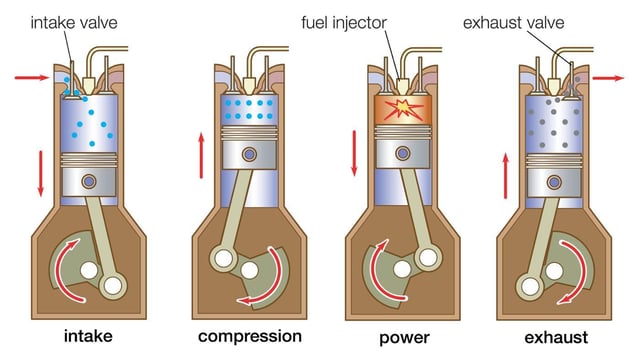
Diesel engines and gasoline engines are both internal combustion (IC)engines. Fuel and air are combined and burned inside the engine to make power. Like a gasoline engine, a diesel engine has cylinders, a crankshaft, connecting rods, and pistons to transfer the energy of the fuel from a linear to rotary motion. The primary difference lies in the way they ignite the fuel/air mixture. Gasoline engine are spark ignition engines and diesel-fueled engines are compression ignition engines.
Four Stroke, Internal Combustion Engine Cycles
- Intake
- Compression
- Combustion (expansion)
- Exhaust
These cycles are essentially the same in both engine types except for the combustion cycle where the gasoline engine is spark initiated and the diesel is compression initiated. The difference is central to the superiority of the diesel for applications requiring high efficiency and high torque functionality with good fuel economy.
COMBUSTION
A gasoline fueled IC engine takes in premixed fuel and air via the induction system, compresses it in each cylinder with a piston and ignites the mixture with a spark plug. Fuel is added during the intake stroke to create a desired air/fuel mixture ready for combustion. The ensuing combustion cycle expands the burning mixture and raises the cylinder pressure to push the piston down and generate torque.
In a diesel engine air and fuel are not pre-mixed. Air is inducted into the cylinders and compressed by the piston to a much higher pressure than in a gasoline engine; up to 25:1 in some cases. This mechanical or adiabatic compression super-heats the air to 400° or more. At this point fuel is injected into the hot compressed air causing it to ignite instantly. Higher cylinder pressure is generated, creating more torque to power the vehicle.
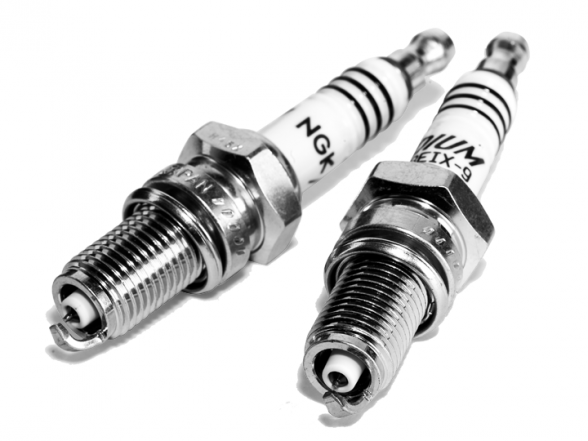
MIXTURE QUALITY
Diesel engines deliver higher efficiency levels for several reasons. One good reason is because the higher cylinder pressure at the time of fuel injection creates a much denser mixture that packs a stronger punch; mixture density being paramount to power creation. Higher compression also makes the fuel burn more completely, releasing more energy because diesel fuel yields a higher energy density. Also, a diesel’s unique ability to inject fuel for a longer portion of the power stroke helps create a higher average cylinder pressure than a comparable gasoline engine. Diesel fuel also has a lubricity component that helps reduce friction in the cylinders.
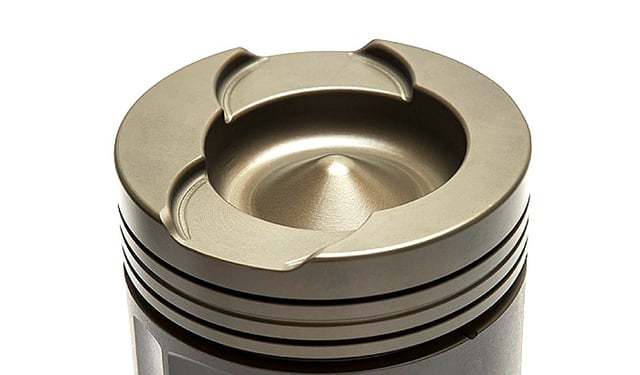
While the initiation of combustion differs from a typical gasoline engine, a fundamental difference also exists in the combustion chamber design to optimize fuel atomization. Most gasoline engines have the combustion chamber in the cylinder head, but in a diesel engine, the combustion chamber is centered inside the piston crown. A diesel piston has a contoured depression or bowl in the center of the piston crown where combustion takes place. In the center of the bowl a cone shaped protrusion sits directly under the fuel injector.
The cone and captured piston chamber beneath the cylinder head promote a highly optimized fuel atomization within the high-pressure combustion space. This cone-in-crown chamber shape is commonly referred to as the “Mexican Hat” (sombrero) design and it is almost universal to diesel pistons. The high efficiency chamber at the center of the piston centralizes most of the force generated by the expansion cycle (combustion) and directs it straight down the connecting rod to the crankshaft throw.
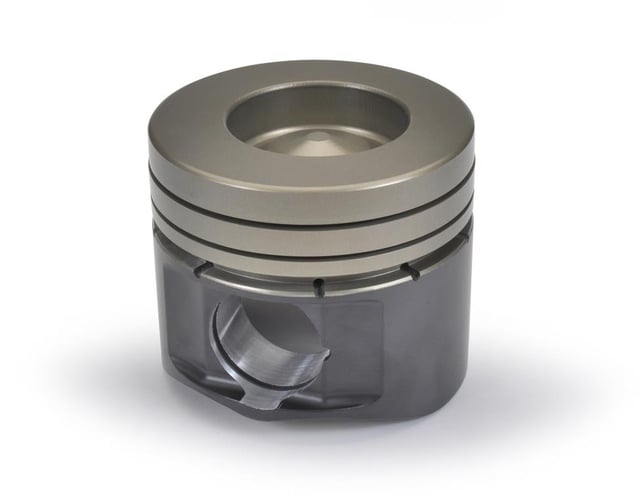
Another difference is that a diesel engine is throttled via the fuel delivery while a gasoline engine is throttled by air delivery. Because the air flow is not throttled, a diesel engine also creates no vacuum. Fuel delivery is accomplished by direct injection into the cylinder, directed straight at the top of the piston. This does great things for fuel mixture quality and subsequent combustion efficiency.
Direct injection makes the combustion process simpler, and more efficient. Diesel engines operate at considerably leaner air fuel ratios than gasoline engines, typically between 25:1 to 40:1 as compared to the normal gasoline range of 12:1 to 15:1. Modern day direct injection diesel engines inject fuel at pressures approaching (or in some cases, exceeding) 30,000 psi. This provides the finest atomization possible for not only an efficient burn, but also one that is low on waste heat. And the lean mixtures are a key reason why diesels are so fuel efficient.
TIMING
Another interesting difference between diesel and gasoline engines is injector timing versus spark timing. In gasoline engines, spark timing refers to the point where combustion is initiated by the spark plug. On a diesel engine, timing refers to the start of the fuel injection event which is timed to take advantage of the point of maximum mixture compression.

TURBOCHARGING
Diesel engines require much stouter components primarily because of the higher cylinder pressures and high torque production. Cylinder pressures are creeping upward to 3,600 psi in modern turbocharged applications and over 8,000 psi in performance applications. On a 4-inch bore, that can amount to 45,000 pounds of pressure pushing the piston down. Hence, the engine block, crankshaft, connecting rods, pistons, cylinder heads, and valves are all considerably more robust than those of a gasoline engine. Because they are designed for high pressure operation, a large percentage of diesel engines are turbocharged.
Turbochargers are ideal for diesels because they repurpose otherwise wasted exhaust gases to effectively boost an engine that is already designed to operate at high cylinder pressures. The thermal efficiency of a diesel engine is effectively improved by turbocharging because it substantially increases the volume of air entering the engine thus allowing the injection of more fuel. The fuel makes the power, but it takes air to unlock it.
The torque-to-horsepower ratio of diesel engines is commonly about 2:1, but many industrial engines achieve ratios of 3:1 or 4:1 as opposed to the typical 1:1 ratio generated by a gasoline engine. Diesels are torque efficient because they make high cylinder pressure from very efficient combustion and they apply it to a long crankshaft stroke which adds leverage. Turbocharging adds a whole new factor to the torque equation because it reduces pumping losses during the intake stroke and dramatically increases cylinder pressure on the power stroke. Diesels love boost pressure. It is not uncommon for diesel engines to run two-, three-, or more-times the boost pressure typically used on gasoline engines.

INJECTION MANAGEMENT
Among other common tuning practices, lengthening the injection event and starting it earlier generates more cylinder pressure. Multiple injection events (pilot injection) per power cycle are now also common. So, combustion is initiated and boosted with further injections during each cycle. This takes maximum advantage of higher boost levels with combustion efficiency to generates higher cylinder pressures.
By nature, the combustion process of a diesel engine tends to resist smoothness and uniformity, primarily because of loading and temperature variations. A crucial goal of tightening control of the injection process is to reduce combustion variations from cycle to cycle. Modern sensors and engine management help smooth things out and today’s diesels are quieter and more powerful than ever. Management systems and higher pressure common rail injection are now capable of up to three injections per combustion event and they can vary each injection with more fuel or less fuel and higher or lower pressure as deemed necessary for optimum combustion.
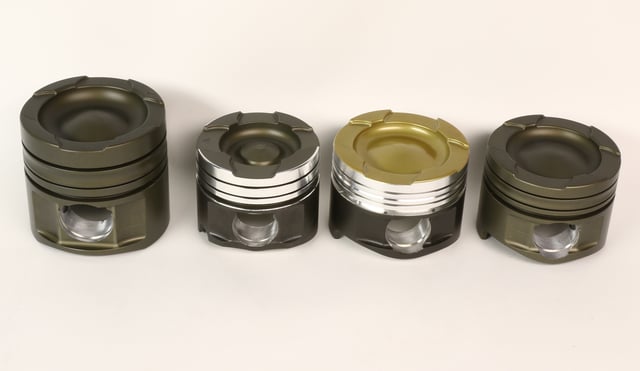
DIESEL PISTON ADVANCEMENTS
All of this makes the piston the point man in the combustion pressure uprising. While diesels typically feature highly robust architecture, the piston is the player that needs to continually step up its game.
Diamond Pistons make a complete line of replacement, forged-aluminum pistons for all the common late-model diesel platforms. Of which, the Dodge Cummins, GM Duramax, and Ford Power Stroke are the main players. These pistons support the diesel performance rebuilder market with standard and oversized billet 2618 alloy pistons that are hard anodized, and come with DLC (diamond like coating) H13 tool steel wrist pins–a great step in providing high quality performance pistons for competition and racing diesel applications.
The diesel market has been exploding for well over a decade. OEM manufacturers and enthusiasts are both driving the technology at a furious pace. Diamond is quickly responding to the burgeoning market demand to make sure they can supply pistons that will meet every performance need for their customers.


